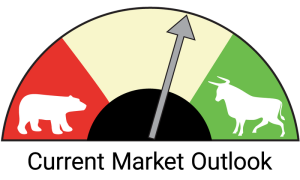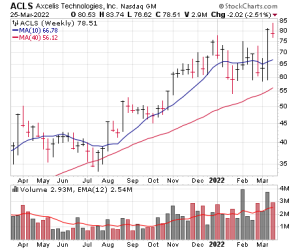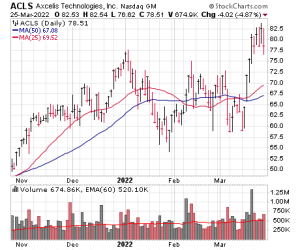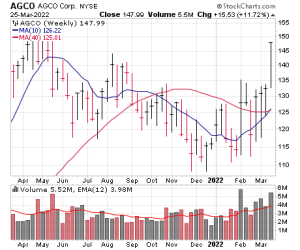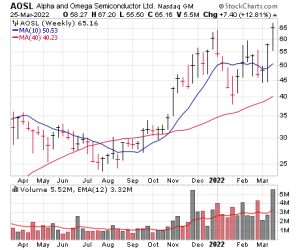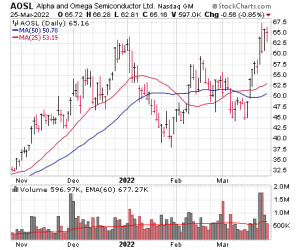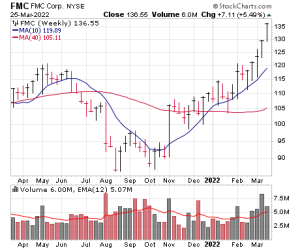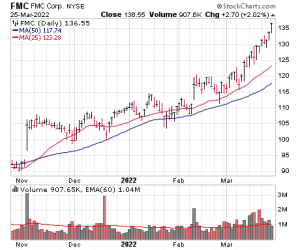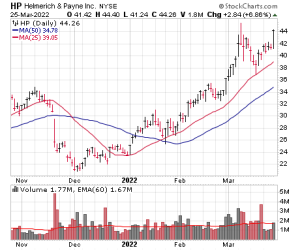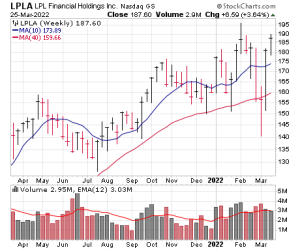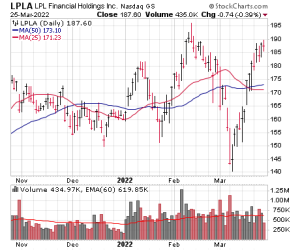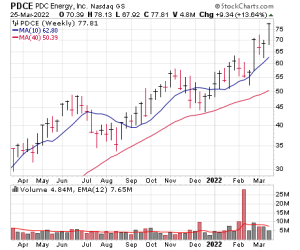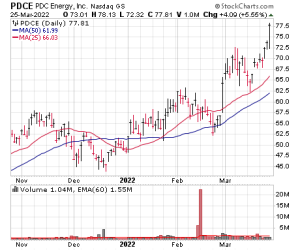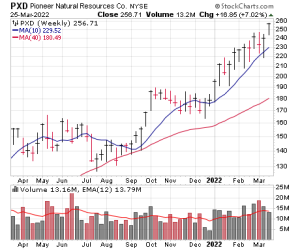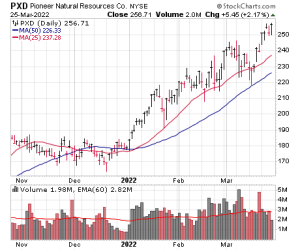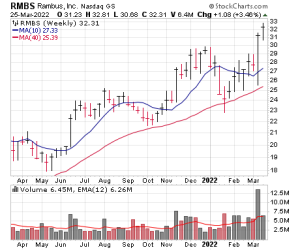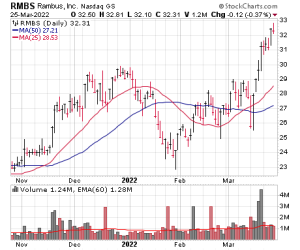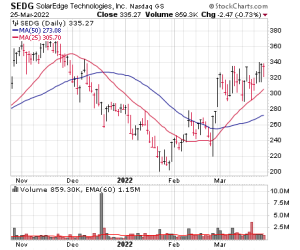In our view, the market still has a good amount of work to do, including when it comes to the intermediate-term trend of the major indexes, the trend of growth funds and for individual stocks, where breakouts to this point remain few and far between. Still, there’s also no question that, after weeks of bottom building, the evidence has certainly improved, with very solid action during the past two weeks among a variety of issues. We’re encouraged, but from here, it’s simply a matter of believing what we see. For now, we continue to favor holding some cash, buying on dips and keeping positions on the small side.
This week’s list is a mix of strong commodity names and some chip and growth titles that have perked up. Our Top Pick is a mid-cap energy name that should thrive in the quarters to come.
Market Overview
More Work to Do, but Getting Better
This isn’t March 2003 or March 2009, where the market had bottomed after a horrific bear market and everything was soaring to the heavens—in our view, the market still has a good amount of work to do, including when it comes to the intermediate-term trend of the major indexes (close to turning up, but not quite yet), the trend of growth funds (a bit behind the major indexes) and for individual stocks (where breakouts to this point remain few and far between). Still, there’s also no question that, after weeks of bottom building, the evidence has certainly improved, with very solid action during the past two weeks among a variety of issues. We’re encouraged, but from here, it’s simply a matter of believing what we see: If the trends can turn up and more stocks get moving, we’ll up our Market Monitor and extend our line, but right here, we’ll stand pat and see what comes. For now, we continue to favor holding some cash, buying on dips and keeping positions on the small side.
This week’s list is a mix of strong commodity names and some chip and growth titles that have perked up. Our Top Pick is PDC Energy (PDCE), a small-cap energy name with a recent acquisition that should lead to ridiculous payouts and buybacks going ahead.
| Stock Name | Price | Buy Range | Loss Limit |
| Axcelis Tech (ACLS) | 78 | 75.5-78.5 | 68.5-69.5 |
| AGCO Corp (AGCO) | 149 | 142-146 | 129-131 |
| Alpha & Omega Semi (AOSL) | 65 | 61.5-64.5 | 53.5-55 |
| FMC Corp (FMC) | 135 | 128-132 | 116.5-118 |
| Helmrich & Payne (HP) | 43 | 39.5-41.5 | 34.5-35.5 |
| LPL Financial (LPLA) | 186 | 181-186 | 165-168 |
| PDC Energy (PDCE) ★ TOP PICK ★ | 74 | 70-73 | 61.5-63 |
| Pioneer Natural Resources (PXD) | 252 | 240-248 | 217-222 |
| Rambus (RMBS) | 33 | 31.5-33 | 27.5-28.5 |
| Solaredge Tech (SEDG) | 332 | 310-323 | 277-284 |
Stock Picks & Previously Recommended Stocks
Stock 1
Axcelis Tech (ACLS)
| Price | Buy Range | Loss Limit |
| 78 | 75.5-78.5 | 68.5-69.5 |
Why the Strength
Demand for semiconductor chips continues to outstrip supply, and that’s expected to persist well into 2022. While bad news for end users (particularly in the automotive industry), this has been a boon for firms like Axcelis that specialize in making equipment essential for chip production. The company’s main offering is its line of Purion high-tech ion implant products that use innovative scanned spot-beam architectures with advanced energy filters to deliver the highest purity, precision and productivity with the lowest cost of ownership. While major automakers like GM have been recently forced to halt production at some of its plants due to the chip shortage, Axcelis is doing its part to help alleviate the problem, announcing multiple shipments of its Purion H200 high current, Purion EXE high energy and the Purion M medium current Power Series implanters to leading Si and SiC power device chipmakers in Asia and Europe (a reason for the strength). The company’s latest financial results are another reason buyers have been in control, as Axcelis posted record revenue, operating profit and gross margin: Systems revenue for the year was $455 million, a 55% increase and also a company record, while fourth-quarter revenue of $206 million climbed 68% and per-share earnings of $1.05 more than doubled and beat the consensus by 21 cents. The results were driven by what management called “unprecedented growth” in the industry and “robust” customer demand for its products in all market segments and geographies. Looking ahead, Axcelis guided for Q1 revenue to increase 45%, while EPS is expected to jump 92%; analysts see the year as a whole bringing a 40% bottom-line bump. The good times won’t last forever, but they should persist for longer than most expect.
Technical Analysis
ACLS has had a big run during the past year, but there have been of dead periods and sharp corrections along the way. The latest of those started in January, with the market’s plunge taking a bite of the stock, but like most of the best names, that proved to be the low—ACLS nearly rallied back to new highs in February, with the retests later that month and in March seeing higher lows. And now, with the market improving, the stock has burst to new highs! We’re OK starting small on the recent dip and adding if things go well.
| Market Cap | $2.61B | EPS $ Annual (Dec) | |
| Forward P/E | 20 | FY 2020 | 1.46 |
| Current P/E | 29 | FY 2021 | 2.88 |
| Annual Revenue | $663M | FY 2022e | 4.01 |
| Profit Margin | 17.4% | FY 2023e | 4.69 |
| Qtrly Rev | Qtrly Rev Growth | Qtrly EPS | Qtrly EPS Growth | |
| ($M) | (vs. yr-ago-qtr) | ($) | (vs.yr-ago-qtr) | |
| Latest qtr | 206 | 68% | 1.05 | 144% |
| One qtr ago | 177 | 60% | 0.81 | 153% |
| Two qtrs ago | 147 | 20% | 0.55 | 41% |
| Three qtrs ago | 133 | 12% | 0.48 | 45% |
Weekly Chart | Daily Chart |
Stock 2
AGCO Corp (AGCO)
| Price | Buy Range | Loss Limit |
| 149 | 142-146 | 129-131 |
Why the Strength
Farming today is more profitable than it has been in years thanks to sky-high crop prices, leaving growers flush with cash to invest in new equipment. AGCO, the world’s largest manufacturer of machinery and equipment focused solely on the ag industry, is seeing the results of farm machine upgrade cycle as its tractors and combine harvesters (including the Challenger, Fendt and Massey Ferguson brands) are used by farmers globally. In Q4, earnings per share of $3.08 more than doubled from a year ago, shredding estimates by $1.31. Revenue of $3.2 billion rose 16% and easily beat estimates, with North American sales jumping 39% to $675 million and South American sales surging 52% to $406 million. Full-year sales, meanwhile, increased 22%, with 2021 operating margins improving by 9%. The blow-out results were fueled by a dramatic improvement in global industry demand for agricultural equipment and were led by sales of AGCO’s “smart farming” solutions. And though the company said it experienced “significant” component shortages that impacted production volumes and higher material and freight costs, it expects farm economics to remain “very healthy” going forward and sees North and South American tractor sales rising around 8% this year. Additionally, AGCO is forecasting continued sales growth and margin expansion based on the “supportive” demand trends it sees continuing in 2022. Indeed, after seeing earnings nearly double last year, the firm expects double-digit growth this year with Wall Street seeing more gains even further out. A modest valuation (14 times earnings) is another plus.
Technical Analysis
Like many farm equipment stocks, AGCO hit a peak last April after a year-long upside run. Shares topped out just shy of 160 and fell in stages over the next eight months before finally bottoming out around 110 in December. There was still plenty of choppiness after that, mainly due to the weak overall market, but as that has changed, it’s allowed AGCO to head higher—shares have rallied strongly the past four weeks, with three showing big upside volume. We’re not expecting a huge pullback, but modest dips should prove buyable.
| Market Cap | $11.0B | EPS $ Annual (Jan) | |
| Forward P/E | 13 | FY 2020 | 5.61 |
| Current P/E | 14 | FY 2021 | 10.38 |
| Annual Revenue | $11.2B | FY 2022e | 11.64 |
| Profit Margin | 7.4% | FY 2023e | 12.68 |
| Qtrly Rev | Qtrly Rev Growth | Qtrly EPS | Qtrly EPS Growth | |
| ($M) | (vs. yr-ago-qtr) | ($) | (vs.yr-ago-qtr) | |
| Latest qtr | 3.16 | 16% | 3.08 | 100% |
| One qtr ago | 2.73 | 9% | 2.41 | 15% |
| Two qtrs ago | 2.88 | 43% | 2.88 | 159% |
| Three qtrs ago | 2.38 | 23% | 2.00 | 133% |
Weekly Chart | Daily Chart |
Stock 3
Alpha & Omega Semi (AOSL)
| Price | Buy Range | Loss Limit |
| 65 | 61.5-64.5 | 53.5-55 |
Why the Strength
Despite the dramatic name, Alpha & Omega Semiconductor plays a supporting role inside smartphones and PCs. Its power semiconductors, like MOSFETs and insulated-gate bipolar transistors, are part of the hardware for the leading smartphone brands in the U.S., Korea and China. The company also sells to the top manufacturers globally for game consoles, graphics cards, appliances and power tools. The positioning in premium brands makes Alpha & Omega’s business more resilient, since economic downturns tend to hurt leading brands less. The company also has seen benefits to expanding into power management integrated circuits, which allows Alpha & Omega to bid for total power frameworks for customers, rather than just providing some components. Power ICs have been growing nearly 50% each of the past two quarters and now constitute $200 million of Alpha & Omega’s $727 million in trailing 12-month sales. That’s helped expand gross margins to 37% as older, more commoditized business becomes less important. Management just sold down to under 50% ownership of a mainland China joint venture, meaning the business comes off its accounting ledgers while allowing the JV to have a Shanghai stock listing that should boost the value of the equity. It reflects the semiconductor industry’s modest shift towards reshoring, which for Alpha & Omega includes an expansion of its Oregon fabrication plant. Stepping back, the chip shortage in the industry and demand for the firm’s wares means customers are already placing deposits for deliveries that won’t come for nearly a year. The numbers have been cranking ahead nicely for a while now, and analysts see earnings taking a step-function leap higher this fiscal year (ending in June).
Technical Analysis
AOSL broke out of a long consolidation in November pushing to a fresh high of 64 entering the year before inflation concerns clipped off more than 25 points in a month. But shares held their 40-week line, rebounded nicely in February and etched a much higher low in March—all signs of potential leadership. And AOSL has taken off on the upside, moving to new highs early last week before chopping around. We’re OK starting a stake here or (preferably) on some weakness.
| Market Cap | $1.74B | EPS $ Annual (Dec) | |
| Forward P/E | 14 | FY 2020 | 0.88 |
| Current P/E | 17 | FY 2021 | 2.93 |
| Annual Revenue | $726M | FY 2022e | 4.61 |
| Profit Margin | 17.6% | FY 2023e | 4.91 |
| Qtrly Rev | Qtrly Rev Growth | Qtrly EPS | Qtrly EPS Growth | |
| ($M) | (vs. yr-ago-qtr) | ($) | (vs.yr-ago-qtr) | |
| Latest qtr | 193 | 22% | 1.20 | 85% |
| One qtr ago | 187 | 23% | 1.06 | 93% |
| Two qtrs ago | 177 | 45% | 0.95 | 228% |
| Three qtrs ago | 169 | 58% | 0.77 | 600% |
Weekly Chart | Daily Chart |
Stock 4
FMC Corp (FMC)
| Price | Buy Range | Loss Limit |
| 135 | 128-132 | 116.5-118 |
Why the Strength
The fertilizer industry is commanding its share of today’s headlines, but lost in the shuffle are companies that provide an equally important role to farmers, namely pesticide producers. Pest management (in the form of herbicides, insecticides and fungicides) are crucial for protecting increasingly valuable crops, with the result that agricultural chemical makers are seeing brighter days. FMC is a leading ag sciences company providing crop protection, plant health and turf management solutions to customers worldwide, with a focus on helping growers boost crop yields. Thanks in no small part of Russia’s invasion of Ukraine, crop prices are expected to boom in the coming months, which should make it easier for FMC to continue raising prices for its farm chemicals. Higher pricing was the key reason behind FMC’s stellar Q4 results, with record revenue of $1.4 increasing 23% from a year ago, driven also by strong selective herbicide volumes and new products. Per-share earnings of $2.16 were 52% higher and beat expectations by 16 cents, despite foreign currency headwinds and challenges with raw material availability. By region, North America sales grew substantially, increasing 81%, due to continued market expansion of FMC’s Rynaxypyr and Cyazypyr active ingredients. Similarly, Latin America revenue grew 30%, driven by “robust” demand in corn and soybeans, price increases and accelerating sales of biologicals. The strong results prompted FMC to authorized a new $1 billion share repurchase program and declare a 53-cent quarterly dividend (1.6% yield). Management guided for Q1 revenue of around $1.28 billion (up 7% at the midpoint) and a midpoint EPS of around $1.70 (up 11%), though odds favor that will be too low. FMC isn’t changing the world, but earnings should remain on a dependable, double-digit growth track for a long time to come.
Technical Analysis
After a solid run to a record high in 2020, FMC peaked in early January last year at 123. It then alternated between that level and the 100 area for the next five months before turning tail in June and nosediving to 87 in August. Shares etched out a double bottom over the following eight weeks and then mounted a comeback that saw FMC make a series of higher highs in each of the five following months. But the real action didn’t begin until the invasion, with shares up four weeks in a row to new highs on big volume. Look for shakeouts of a few points to enter.
| Market Cap | $17.2B | EPS $ Annual (Dec) | |
| Forward P/E | 18 | FY 2020 | 6.19 |
| Current P/E | 19 | FY 2021 | 6.93 |
| Annual Revenue | $5.03B | FY 2022e | 7.73 |
| Profit Margin | 19.4% | FY 2023e | 8.74 |
| Qtrly Rev | Qtrly Rev Growth | Qtrly EPS | Qtrly EPS Growth | |
| ($M) | (vs. yr-ago-qtr) | ($) | (vs.yr-ago-qtr) | |
| Latest qtr | 1.41 | 23% | 2.16 | 52% |
| One qtr ago | 1.19 | 10% | 1.43 | 17% |
| Two qtrs ago | 1.24 | 8% | 1.81 | 5% |
| Three qtrs ago | 1.19 | -4% | 1.53 | -17% |
Weekly Chart | Daily Chart |
Stock 5
Helmrich & Payne (HP)
| Price | Buy Range | Loss Limit |
| 43 | 39.5-41.5 | 34.5-35.5 |
Why the Strength
The need for increased petroleum production to relieve record-high fuel prices has rarely been greater, with the White House calling on oil drillers to boost production in order to ease the pain at the gas pump. While some big oil producers are slow to increase output, others have answered the call, and overall it’s a sure bet demand for drilling services is headed higher after a multi-year dry spell. Tulsa-based Helmerich & Payne is a well-managed oil services and contract drilling outfit that has survived the downcycle in great shape (no debt maturities until 2031; investment grade debt rating; plenty of liquidity and a dividend that yields 2.3%) and is poised to see results turn up dramatically in the quarters to come. Although H&P’s North America Solutions segment sustained a $29 million operating loss in Q4 (due to higher costs), the company said it exited the quarter with 154 of its rigs in use, 21% higher than the prior quarter and up 64% from a year ago. Consequently, total revenue in Q1 soared 66% from a year ago, while a per-share loss of 45 cents topped estimates by 2 cents. And that momentum has continued, with its rig count rising to 174 by the end of January! Back to Q4, by operating segment, revenue from the company’s International Solutions leaped 254% from a year ago, North America Solutions rose 69% and Offshore Gulf of Mexico edged up 9%. H&P said that while increasing demand for its super-spec rigs has led to a “very tight” market this year due to near-term scarcity of readily available rigs, it has 271 total rigs in its fleet (including 162 super-spec available in the U.S.) so there’s still upside ahead. Management added that drilling activity in the international market is positive, while South America activity is slowly improving and the firm anticipated additional growth in the coming quarters and beyond. Looking ahead, analysts still see the firm losing money this fiscal year (ending in September), but (a) cash flow looks stronger than earnings and (b) those estimates are probably too conservative.
Technical Analysis
For much of 2021, HP lagged its industry peers as shares churned mostly sideways for the first 10 months of that year, gyrating between the 25 and 35 levels. After tagging the high end of the range in November, the stock plunged to 22 on earnings. But that dip to multi-month lows was the final shakeout—with oil prices surging, the stock bottomed quickly and was in recovery mode by December and has trended higher since. As with many energy names, we think HP can go higher, but also think further near-term pullbacks are likely.
| Market Cap | $4.67B | EPS $ Annual (Sep) | |
| Forward P/E | N/A | FY 2020 | -0.83 |
| Current P/E | N/A | FY 2021 | -2.58 |
| Annual Revenue | $2.00B | FY 2022e | -0.95 |
| Profit Margin | N/A | FY 2023e | 0.58 |
| Qtrly Rev | Qtrly Rev Growth | Qtrly EPS | Qtrly EPS Growth | |
| ($M) | (vs. yr-ago-qtr) | ($) | (vs.yr-ago-qtr) | |
| Latest qtr | 410 | 66% | -0.45 | N/A |
| One qtr ago | 344 | 65% | -0.62 | N/A |
| Two qtrs ago | 332 | 5% | -0.57 | N/A |
| Three qtrs ago | 296 | -53% | -0.60 | N/A |
Weekly Chart | Daily Chart |
Stock 6
LPL Financial (LPLA)
| Price | Buy Range | Loss Limit |
| 186 | 181-186 | 165-168 |
Why the Strength
LPL Financial is the largest independent broker-dealer in the U.S., the top provider of third-party brokerage services to banks and credit unions and the top custodian to registered investment advisors. Thus, it’s a straightforward Bull Market stock—a company whose business rises and falls along with asset prices and investor money flows—so if the current uptrend turns into a big rally, there’s little doubt the firm will grow nicely. Indeed, at the end of February, the firm had $1.15 billion of advisory and brokerage assets (split fairly equally between the two), and while that was down a smidge from year-end (due to the market’s decline), it was up 24% from a year ago (thanks in part of last year’s purchase of Waddell & Reed) and new assets were still coming in at a solid clip. Beyond that, though, are short-term interest rates—the Fed’s increased hawkishness is likely to drive up rates more than was anticipated just a couple of months ago, and that means extra fee income for the firm’s large cash balances; every 0.25% hike in the funds rate should boost LPL’s gross margin by $1.10 per share. Put it all together and we could have a perfect environment for the company, with a still-healthy investing environment plus rising rates—as opposed to many financial outfits, Wall Street sees the firm’s bottom line surging 34% this year and another 44% in 2023. Obviously, there’s a decent amount outside of the firm’s control, which is a negative, but it certainly looks like both major levers could be moving in the same direction in the months ahead.
Technical Analysis
LPLA has had a few false starts during the past few months, but now that’s looking like a positive since it likely shook out the remaining weak hands. Just this year, we saw moves to new highs in both January and February rejected, with the March dip being a big doozy. But more impressive than that is the smoke-up-a-chimney-type of advance since the recent lows, with LPLA gliding most of the way back toward all-time highs. We won’t argue with a nibble here, though we’d prefer to get some on a normal retreat.
| Market Cap | $15.0B | EPS $ Annual (Dec) | |
| Forward P/E | 20 | FY 2020 | 6.46 |
| Current P/E | 27 | FY 2021 | 7.02 |
| Annual Revenue | $7.72B | FY 2022e | 9.39 |
| Profit Margin | 6.4% | FY 2023e | 13.53 |
| Qtrly Rev | Qtrly Rev Growth | Qtrly EPS | Qtrly EPS Growth | |
| ($M) | (vs. yr-ago-qtr) | ($) | (vs.yr-ago-qtr) | |
| Latest qtr | 2.09 | 32% | 1.63 | 7% |
| One qtr ago | 2.02 | 38% | 1.77 | 23% |
| Two qtrs ago | 1.9 | 39% | 1.85 | 30% |
| Three qtrs ago | 1.71 | 17% | 1.77 | -14% |
Weekly Chart | Daily Chart |
Stock 7
PDC Energy (PDCE) ★ Top Pick
| Price | Buy Range | Loss Limit |
| 74 | 70-73 | 61.5-63 |
Why the Strength
Last week we wrote about Oasis Petroleum, saying it might have the best small-cap energy cash flow story out there. But PDC Energy looks just as good, and interestingly, like Oasis, some of it has to do with a recent acquisition. PDC Energy spent most of last year using a torrent of cash flow to pay down debt, buy back some shares and pay some decent dividends, but a huge increase in those returns is just over the horizon: The company has had a good-sized position in the Wattenberg field in central Colorado, and now it’s spending a combined $1.3 billion (including cash, assuming some debt and a few extra shares) to buy another 54,000 acres (now 230,000 total) in that area, with the extra acreage currently cranking out 55,000 barrels of energy per day; there’s also another 125 either drilled or permitted wells on the land, plus a couple hundred other identified locations. (At $75 oil, all regions of the acreage should result in well returns north of 100%!) The buyout should be accretive from the get-go, and once it closes (expected in Q2), PDC will begin paying out 60% of free cash flow to shareholders via a base dividend (now 25 cents per share, per quarter, rising to 35 cents once the deal closes), special dividends and share buybacks (including $1.25 billion of buybacks by year-end 2023). To put numbers on it, PDC expects a ridiculous $27 per share of combined free cash flow both this year and next, with around $17 of that being returned—and that’s assuming $75 oil and $4 natural gas prices, both of which are well below the market. To be fair, the firm will have $1.8 billion of debt after the purchase (about double what it had previously), so some of that will have to be trimmed, but there should be plenty of money to go around in the next few years even if energy prices ease.
Technical Analysis
PDCE ran up to 59 in November where it began to build its most recent launching pad—and unlike many peers, it didn’t really take off at the start of the year, with a push to 63 followed by a dip to 52 in February. But since then, (a) higher prices due to the invasion, (b) a great Q4 earnings report and (c) the add-on acquisition have served to kicked PDCE to much higher highs, including last Friday’s surge. Pullbacks look buyable, though we’re not expecting a huge retreat given the cash flow profile here.
| Market Cap | $7.50B | EPS $ Annual (Dec) | |
| Forward P/E | 5 | FY 2020 | -6.36 |
| Current P/E | 9 | FY 2021 | 8.22 |
| Annual Revenue | $1.86B | FY 2022e | 14.38 |
| Profit Margin | 33.1% | FY 2023e | 14.14 |
| Qtrly Rev | Qtrly Rev Growth | Qtrly EPS | Qtrly EPS Growth | |
| ($M) | (vs. yr-ago-qtr) | ($) | (vs.yr-ago-qtr) | |
| Latest qtr | 855 | 207% | 2.86 | 160% |
| One qtr ago | 486 | 95% | 2.33 | 124% |
| Two qtrs ago | 229 | 321% | 1.66 | 999% |
| Three qtrs ago | 286 | -62% | 1.41 | N/A |
Weekly Chart | Daily Chart |
Stock 8
Pioneer Natural Resources (PXD)
| Price | Buy Range | Loss Limit |
| 252 | 240-248 | 217-222 |
Why the Strength
As we saw today, the near-term with many energy stocks (and commodity stocks more broadly) could be tricky—there’s a lot of hot money that could turn tail—but big picture, odds favor the uptrends continuing after pullbacks. Pioneer Natural Resources is an emerging blue chip in the exploration segment, and there’s a couple of key reasons why it’s become an institutional favorite. The first is that the company got a head start on the current flat production/low CapEx/huge cash flow movement in the sector, cutting back years ago and, after December’s sale of some acreage to Continental Resources for $3.25 billion, Pioneer is a pure play on the Midland Basin (largest acreage holder there) that sports buoyant well returns, with drilling inventory of more than a decade. Moreover, the firm used those proceeds to slash its debt (currently around 0.5x cash flow, declining to 0.2x by year-end 2022) and cover its hedges (no oil hedges as of January) so there’s not much else to do with its tremendous cash flows except return them to shareholders—and that’s the main attraction. Indeed, Pioneer’s plan is to pay out around 80% of its free cash flow each quarter, and for 2022, that translates into beefy payments that should total $20 per share or so at $80 oil and $27 per share at $100 oil (even at $60 oil, the stock will probably pay $14 in dividends in total this year). And that doesn’t include any share buybacks, which, while not a main part of the return story, should be available if the stock hits the skids. If Pioneer sticks to its guns and keeps CapEx in check, there’s no reason the firm can’t have huge payouts for many years to come.
Technical Analysis
PXD did well last year, but the real eye-opener came at the start of the year, when shares broke out of a three-month structure on a string of big-volume days. Since then the stock has had a few pullbacks, but all were contained by the 50-day line, including the last dip in mid March. The recent push to new highs came on moderate volume—we think PXD is fine, but dips into the mid 240s would be more tempting.
| Market Cap | $62.4B | EPS $ Annual (Dec) | |
| Forward P/E | 10 | FY 2020 | 2.05 |
| Current P/E | 19 | FY 2021 | 13.26 |
| Annual Revenue | $14.6B | FY 2022e | 25.90 |
| Profit Margin | 27.3% | FY 2023e | 22.74 |
| Qtrly Rev | Qtrly Rev Growth | Qtrly EPS | Qtrly EPS Growth | |
| ($M) | (vs. yr-ago-qtr) | ($) | (vs.yr-ago-qtr) | |
| Latest qtr | 4.32 | 133% | 4.58 | 328% |
| One qtr ago | 4.46 | 158% | 4.13 | 999% |
| Two qtrs ago | 3.42 | 308% | 2.55 | N/A |
| Three qtrs ago | 2.44 | 8% | 1.77 | 53% |
Weekly Chart | Daily Chart |
Stock 9
Rambus (RMBS)
| Price | Buy Range | Loss Limit |
| 33 | 31.5-33 | 27.5-28.5 |
Why the Strength
There are 27 billion connected devices capturing, uploading and requesting data worldwide, up 10 billion in the past five years as Internet of Things and cloud services proliferate. That’s creating huge pressures on servers to balance workloads, which is playing into Rambus’ hands, as it focuses on advanced silicon chips and intellectual property for data centers. The company emphasizes two benefits for customers – working around bottlenecks of processing demand and superior data security. Server chip demand is rising, with Rambus’ pitch being that its architectures allow better CXL Memory Pooling, a term for resource sharing among processors and memory, allowing data servers to combine resources to speed data transfer. Since last year, the company has made three acquisitions to boost its CXL efforts in both high power and low power environments. Since data centers are prime targets for hackers, the company focuses a lot of effort on programming security, such eliminating vulnerabilities to fault injection (when errors are purposefully introduced to software to crack open firewalls) as well as physical security (where cryptography and anti-tampering defenses are hard wired on processors). Rambus generates revenue from all this in three ways – physical hardware sales, licensing fees and royalties from IP used by other chip makers (the latter of which contribute to healthy profit margins). Combined, all of that amounted to $328 million in sales last year and earnings of 62 cents, up sharply from the prior year. There should be more of that coming this year, with analysts see earnings lifting to nearly $1.50 per share.
Technical Analysis
RMBS broke out of a multi-year trading range at the end of 2020, and has found support near its 40-week many times since then, keeping its overall uptrend intact. The latest correction, of course, came due to the market’s plunge at the start of the year, with a sharp dip to 23 (and the 40-week line) in late January, but then came two higher lows (25 and 26) and February/March and ten a strong-volume push to new highs two weeks ago. We’re not opposed to nibbling here, though we’d prefer to get shares on a dip back toward support at 30.
| Market Cap | $3.53B | EPS $ Annual (Jan) | |
| Forward P/E | 22 | FY 2020 | 0.17 |
| Current P/E | 52 | FY 2021 | 0.62 |
| Annual Revenue | $328M | FY 2022e | 1.47 |
| Profit Margin | 23.0% | FY 2023e | 1.57 |
| Qtrly Rev | Qtrly Rev Growth | Qtrly EPS | Qtrly EPS Growth | |
| ($M) | (vs. yr-ago-qtr) | ($) | (vs.yr-ago-qtr) | |
| Latest qtr | 91.8 | 48% | 0.18 | 260% |
| One qtr ago | 81.3 | 43% | 0.14 | 600% |
| Two qtrs ago | 84.9 | 37% | 0.20 | 400% |
| Three qtrs ago | 70.4 | 7% | 0.10 | 67% |
Weekly Chart | Daily Chart |
Stock 10
Solaredge Tech (SEDG)
| Price | Buy Range | Loss Limit |
| 332 | 310-323 | 277-284 |
Why the Strength
With conventional energy prices booming, consumers and business owners are turning to solar solutions for their power needs, while governments are giving solar a closer look to wean their dependence from imported oil. Israel-based SolarEdge offers power optimizer, solar inverter and monitoring systems for photovoltaic arrays, helping customers turn their homes and businesses into renewable energy hubs. The company is one of the biggest players in the solar power field, also providing residential, commercial and large-scale solar panels, as well as energy storage and backup, electric vehicle charging and battery packs. The big idea here is the firm’s inverters, products that are effectively the boss of a PV system, helping to maximize power generation and lowering the cost of energy produced; SolarEdge is a worldwide leader along with peer Enphase Energy. SolarEdge exited 2021 with record yearly and quarterly revenue (a reason for the strength); the company said global demand for solar energy across all its segments and geographies was “extremely strong” and is generating “unprecedented” demand for its products, particularly among U.S. commercial clients. Although per-share earnings of $1.10 missed the consensus by 22 cents, SolarEdge reported total revenue of $552 million in Q4, an eye-popping 54% improvement from a year ago and 5% higher from the prior quarter, while 2021 sales jumped 35% to almost $2 billion. Going forward, the company’s focus is on ramping up production of a battery storage product with partner Samsung, while expanding into the utility space with a large-scale 330-kilowatt inverter (currently in the testing phase). Management guided for Q1 revenue to come in between $615 and $645 million, up 56% at the midpoint if realized and in-line with estimates, with solar segment revenue to average $585 million (up 79%).
Technical Analysis
Between 2019 and 2021, SEDG was in hyper-growth mode along with the rest of the solar sector. It mushroomed from just under 40 two years ago to around 380 in early 2021 before hitting a wall. From there, SEDG slid to 200 by May and then rebounded to the old high, but the recovery didn’t stick and shares again backslid to 200 by January. But the last eight weeks have witnessed a character change, with shares rising into the 330 range and then holding its ground the past couple of weeks. Day-to-day volatility is extreme, so we’ll set our buy range down a bit from here.
| Market Cap | $18.4B | EPS $ Annual (Dec) | |
| Forward P/E | 66 | FY 2020 | 4.11 |
| Current P/E | 70 | FY 2021 | 4.81 |
| Annual Revenue | $1.96B | FY 2022e | 5.06 |
| Profit Margin | 11.4% | FY 2023e | 7.79 |
| Qtrly Rev | Qtrly Rev Growth | Qtrly EPS | Qtrly EPS Growth | |
| ($M) | (vs. yr-ago-qtr) | ($) | (vs.yr-ago-qtr) | |
| Latest qtr | 552 | 54% | 1.10 | 12% |
| One qtr ago | 526 | 56% | 1.45 | 20% |
| Two qtrs ago | 480 | 45% | 1.28 | 32% |
| Three qtrs ago | 406 | -6% | 0.98 | 3% |
Weekly Chart | Daily Chart |
Previously Recommended Stocks
Below you’ll find Cabot Top Ten Trader recommended stocks. Those rated HOLD are stocks that traded within our suggested buy range within two weeks of appearing in the Top Ten and still look good; hold if you own them. Stocks rated WAIT have yet to dip into our suggested buy range … but can be bought if they do so within the next week.
Those stocks rated SELL should be sold if you own them; they will no longer be listed here. Finally, Stocks in the DROPPED category are those that failed to trade within our buy range within two weeks of our recommendation; that’s not a bad thing, we just never got the price we wanted. Please use this list to keep up with our latest thinking, and don’t hesitate to call or email us with any questions you may have. New recommendations each week are in bold.
| Date | Stock | Symbol | Top Pick | Original Buy Range | Price as of 3/28/2022 |
| HOLD | |||||
| 3/14/22 | Agnico Eagle | AEM | 57.5-59.5 | 60 | |
| 2/28/22 | Allegheny Tech | ATI | 23.5-25 | 27 | |
| 3/21/22 | Alpha Metallurgical | AMR | 116-124 | 132 | |
| 3/14/22 | Antero Resources | AR | 23-24.5 | 31 | |
| 11/8/21 | Arista Networks | ANET | ★ | 129-134 | 139 |
| 2/28/22 | Barrick Gold | GOLD | 22-23 | 24 | |
| 3/14/22 | Cameco | CCJ | 24.5-26 | 28 | |
| 2/28/22 | CarGurus | CARG | 44.5-47 | 42 | |
| 3/14/22 | Century Aluminum | CENX | 24-25 | 28 | |
| 1/3/22 | CF Industries | CF | 67-69 | 105 | |
| 1/31/22 | Chesapeake Energy | CHK | 66-68.5 | 88 | |
| 3/7/22 | Civitas | CIVI | 53-56 | 62 | |
| 3/14/22 | CrowdStrike | CRWD | 176-184 | 222 | |
| 5/10/21 | Devon Energy | DVN | ★ | 25-26.5 | 60 |
| 2/7/22 | Dutch Bros. | BROS | 54.5-58 | 56 | |
| 3/14/22 | Fluor | FLR | 27-28.5 | 30 | |
| 2/28/22 | Freeport McMoRan | FCX | 45-47 | 50 | |
| 3/7/22 | Globalfoundries | GFS | 54-56.5 | 74 | |
| 1/18/22 | Halliburton | HAL | 27-28 | 37 | |
| 3/21/22 | Hilton | HLT | 147-151 | 151 | |
| 1/31/22 | Intra-Cellular Tech | ITCI | 45-48 | 61 | |
| 3/21/22 | Lantheus | LNTH | 52-54 | 52 | |
| 3/7/22 | Lockheed Martin | LMT | 450-470 | 445 | |
| 2/28/22 | Matson | MATX | 103-107 | 122 | |
| 1/24/22 | Newmont Mining | NEM | 61.5-63 | 78 | |
| 2/14/22 | Nucor | NUE | 114-118 | 154 | |
| 1/10/2022 | Marathon Oil | MRO | 17.0-17.8 | 25 | |
| 3/21/2022 | Oasis Petroleum | OAS | 147-152 | 146 | |
| 2/14/2022 | Occidental Petroleum | OXY | 38-40 | 57 | |
| 3/7/2022 | Onsemi | ON | 57.5-59.5 | 65 | |
| 3/7/2022 | Palo Alto Networks | PANW | ★ | 525-540 | 625 |
| 3/7/2022 | Patterson-UTI | PTEN | 14-15 | 15 | |
| 1/10/2022 | Pioneer Natural Res. | PXD | 194-198 | 253 | |
| 3/21/2022 | Pure Storage | PSTG | ★ | 33-35 | 36 |
| 1/31/2022 | Regeneron Pharm | REGN | 630-645 | 693 | |
| 3/7/2022 | Royal Gold | RGLD | 123-127 | 140 | |
| 2/22/2022 | Seaworld | SEAS | 65-68 | 72 | |
| 2/22/2022 | StarBulk Carriers | SBLK | 30-31 | 30 | |
| 3/7/2022 | Steel Dynamics | STLD | 70-73 | 87 | |
| 3/14/2022 | Sweetgreen | SG | 30-32.5 | 35 | |
| 3/14/2022 | Westlake | WLK | ★ | 117-121 | 125 |
| 1/3/2022 | ZIM Shipping | ZIM | ★ | 55-57.5 | 72 |
| WAIT | |||||
| 3/21/2022 | MP Materials | MP | 45.5-48 | 55 | |
| 3/21/2022 | Nutrien | NTR | 97-101 | 107 | |
| SELL RECOMMENDATIONS | |||||
| 1/24/22 | Concentrix | CNXC | 170-175 | 195 | |
| 2/7/22 | Juniper Networks | JNPR | 34-35 | 37 | |
| 1/18/22 | Nextstar Media | NXST | 161.5-165.5 | 187 | |
| 2/28/22 | Reliance Steel | RS | 178-184 | 191 | |
| 2/22/22 | Titan International | TWI | 10.5-11 | 15 | |
| DROPPED | |||||
| None this week | |||||
The next Cabot Top Ten Trader issue will be published on April 4, 2022.
